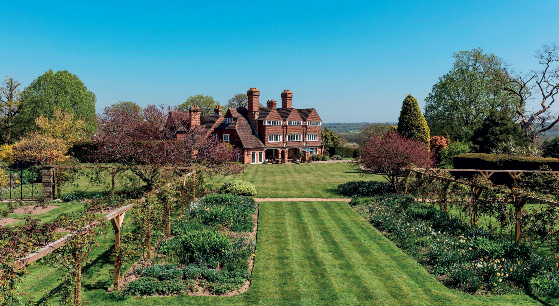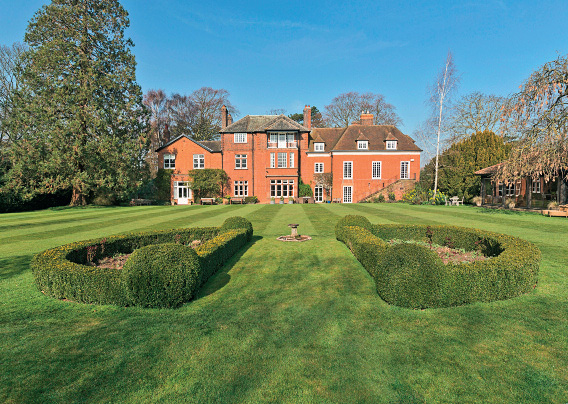Lutyens Houses on the Market
Richard Page’s regular property column
One fascinating aspect of following the sale of Lutyens houses is that, due to his prodigious output, there are always some which come onto the market. This summer saw a number of important houses come up for sale, each with a story to tell.
Photography by Forest Eyes Photography
Crooksbury House, Farnham, Surrey
Crooksbury was Lutyens’s first country-house commission, which came from Arthur Chapman, a family friend and chairman of the Farnham Liberals. Lutyens was 20 at the time and a pupil in Ernest George’s office. This 1889 commission enabled Lutyens to set up his own practice at 6 Gray’s Inn Square, London. Crooksbury is of additional interest in that Lutyens was called back twice — to extend it in 1898 for Chapman and part-remodel it for new owners in 1914.
The property for sale is the house’s eastern wing, which dates from 1898. It was originally constructed in a formal neo-Georgian style, which showed that Lutyens was already beginning to experiment with classicism (as did his design for the Farnham Liberal Club of 1894, also commissioned by Chapman). But this proved short-lived as a new owner in 1914 wanted a return to the vernacular style and Lutyens, rather than allow anyone else to interfere, rebuilt the wing in the traditional timber-and-tile Arts and Crafts style that survives today. But what a gem it is. Now Grade II-listed, the house has seven bedrooms, five bathrooms, a 35-ft drawing room, oak-panelled dining room, study, family room and kitchen/ breakfast room, in all offering 5,900 sq ft of accommodation. There are also a swimming pool and summerhouse set in 6.5 acres of Gertrude Jekyll-designed grounds and gardens. Guide price: £2.5m through Hamptons International.
(The neighbouring property mentioned in the last newsletter, comprising the Cottage, Clock House and Dovecote, all by Lutyens, has now found a buyer.)
The Ruckmans Estate, Okewood Hill, Dorking, Surrey
In 1894, Lutyens, aged 25, was commissioned by the Lyell family to extend and remodel an existing 17th-century farmhouse. This resulted in one of the first houses to show the distinctive Lutyens style, his grasp of form and Surrey building traditions. The original building, with its Horsham stone roof, was retained but extended by the same size again to the southwest, together with a new kitchen wing to the northwest with tiled roofs and tile hanging and massive chimney stacks. Of particular note are the strongly horizontal windows on the southwest elevation, which run along the three gables oversailing a ground-floor verandah.
Lutyens returned in 1902 to add a music room which, as described by architect Roderick Gradidge, “stands proudly from the main house and is in a different style with tall, arched, many-paned sash windows which contrast with the horizontal leaded windows of the earlier house, but the simple hips of the roof marry perfectly with the earlier roofs. Thus, although he uses a completely different style for his additions, the whole hangs together to make an entirely cohesive design.”
Today the house forms the centrepiece of a 507-acre estate which includes the 10,600-sq ft, eight-bedroom, seven-bathroom main house with four reception rooms set in Jekyll gardens. The estate also incorporates seven cottages, a dower house, four-bed farmhouse and two traditional barns with planning potential, as well as some excellent farm and commercial buildings. Guide price: £12m through Savills.
Mesnil Warren, Newmarket, Suffolk
This substantial, 19th-century house and former racing lodge has commanding views over Newmarket Heath and the Warren Hill Gallops. The house was bought in 1908 by Lord Derby’s racehorse trainer, the Hon George Lambton, who was married to Cicely Horner (of Mells, Somerset). The story goes that Lambton, having placed big bets over the winter months on his Derby entrant, Sansovino, received a huge payout when the horse won the 1924 race. This windfall funded not only the building works for an extension to his house but the engagement of the by then internationally famous architect Lutyens.
The new north wing was built in 1925 on a predominantly u plan over three storeys of mellow red brick under a hipped tile roof with deep cornice and dormers. The kitchen, which fills in the open part of the u on the ground floor, has a full-width rooflight. The extensive 10,000-sq ft property includes seven reception rooms, 11 bedrooms, five bathrooms, a self-contained two-bed flat and 2.5-acre garden. The house has remained in the ownership of the Lambton family who are now offering it for sale. Guide price: £2.95m through Savills.
White Lodge, Roedean, Brighton, Sussex
This property on the cliffs of Roedean is of interest not so much for its architectural qualities as for the witness it bore to a significant period in Lutyens’s life while his wife Emily pursued her obsession with theosophy and Krishnamurti. His client in this case was Victoria, Lady Sackville (of Knole and mother of Vita Sackville-West) whom Lutyens first met in 1916. A relationship followed which became exceptionally close. Lady Sackville, whom he nicknamed McSack, owned a succession of properties including on Ebury Street in Belgravia, Hill Street in Mayfair and Sussex Square in Brighton, for which “McNed” (as she dubbed him) either developed plans for or handled alterations. In 1923, Lady Sackville bought White Lodge and, over the following years, Lutyens remodelled and extended it. Within the grounds, he built a romantic sunken rose garden with a geometric pattern of slate and stone. This period of Lutyens’s life has been summed up as follows by Jane Ridley: “McSack was his muse. With her, Ned could pun and smoke, play interminable patience, draw rude pictures and eat good food. Wrapped in her
comfort, warmed by her sun, he could escape into the intellectual world that mattered to him: the world of pure geometry and proportion.”
White Lodge has since been altered and subdivided. The property for sale is a 1,500sq ft, ground-floor, three-bed, two-bathroom apartment with a south-facing garden. Guide price: £750,000 through Brand Vaughan.
7 St James’s Square, London SW1
This house was originally built in 1911 for the Farrer brothers. It is being offered in “shell” condition with planning and listed building consent to restore it to its former glory as a single residence of 30,000 sq ft. The building is next door to 8 St James’s Square, recently built to a new design by Eric Parry — see the Newsletter piece on this on page 3.
Price: on application through joint agents Knight Frank and Savills.
Richard Page is marketing director for the London and Premier brands of Countrywide plc, and has advised on the sale of many Lutyens houses. Please contact him with any Lutyens-related property news at rpage@countrywide.co.uk.
Disclaimer: prices and availability correct at time of going to press.






